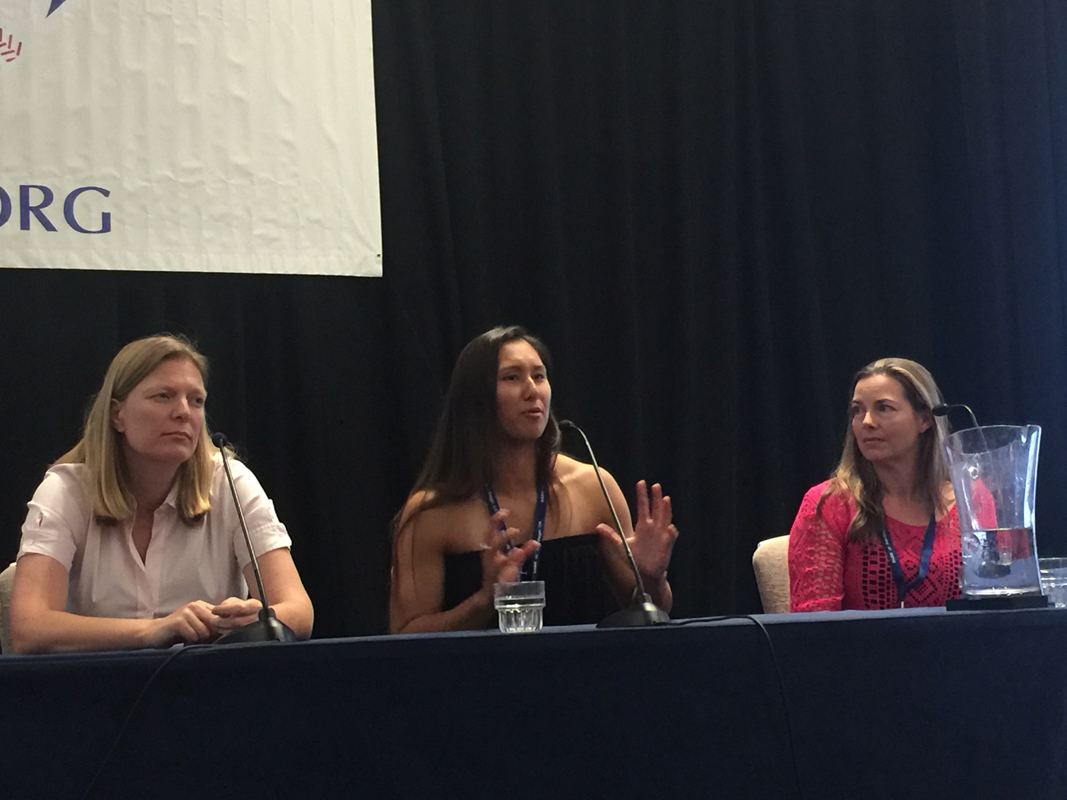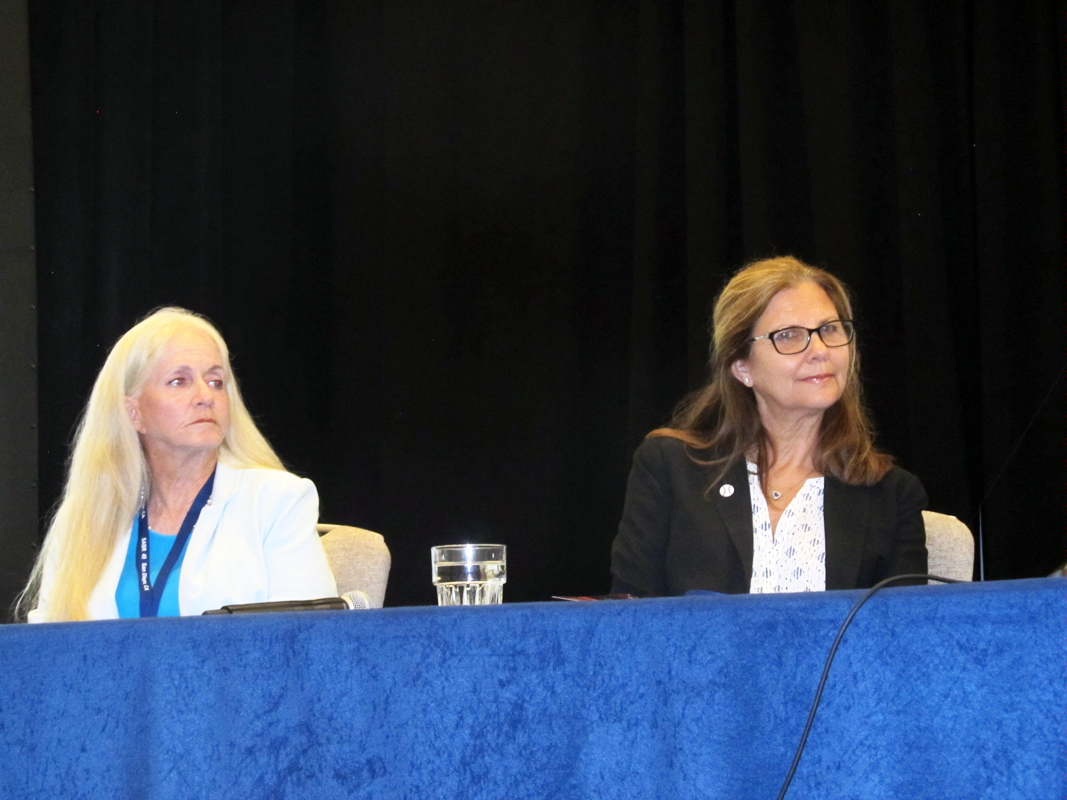SABR 49: Listen to highlights from the Women in Baseball panel
 At SABR 49 on June 27, 2019, in San Diego, our Women in Baseball Panel talked about their lives and careers in the game and what they hope the future brings for women in the sport.
At SABR 49 on June 27, 2019, in San Diego, our Women in Baseball Panel talked about their lives and careers in the game and what they hope the future brings for women in the sport.
Our panelists included Ila Borders, the first woman to pitch in baseball’s minor leagues with the Northern League’s St. Paul Saints; Perry Barber, professional baseball umpire; Jewel Greenberg, producer of Girls of Summer: Big Diamond Dreams; Justine Siegal, founder of Baseball For All and the first female coach in Major League Baseball; Janet Marie Smith, Senior Vice President of Planning and Development for the Los Angeles Dodgers; Kelsie Whitmore of the US National Women’s Baseball Team and the Sonoma Stompers; and moderator Jean Ardell, author of Breaking into Baseball: Women and the National Pastime and co-author with Ila Borders of Making My Pitch: A Woman’s Baseball Odyssey.
- Audio: Click here to listen to the SABR 49 Women in Baseball Panel (MP3; 58:26)
Here are some highlights:
ON A QUARTER-CENTURY OF PROGRESS
- Ardell: “In 1993 I attended my first SABR convention right here in San Diego. There were exactly 2 women presenting, me and Barbara Gregorich. Where were all of you in 1993? Well, Kelsie, you weren’t even born yet …”
- Whitmore: “Yeah, I was born in 1998. I grew up playing baseball since I was 6 years old. It was always fun for me. My dad really got me involved and I stuck with it ever since. I was not looked at differently at the youth level. I felt like one of the guys. But later the boys started to realize I was different. They see hey, that’s someone with long hair … that’s different. It was mostly positive, but there were some negatives as well as positives growing up.”
- Barber: “In 1993 I was working NCAA baseball games and high school doubleheaders and I was about to get married. I told my husband I needed to be on dry land on the weekends because he wanted to be on his boat! By then I was 12 years into my umpiring career and I was realizing I was never going to break what I called the “stained grass ceiling” of baseball. I wasn’t going to make it to the big leagues, but I thought someday someone would and I could be a part of that.”
- Smith: “In 1993, Camden Yards had just opened! Baltimore was going to be hosting the All-Star Game that year. When I first started working in baseball, I didn’t think it was going to be a career trajectory for me. My work was about civic architecture and urban planning. I am about cities and civic spaces, and creating ballparks that are civic spaces. I thought after the Orioles I’d move on to other urban planning, but I stayed with baseball.”
- Borders: “I was a senior in high school and I was all about baseball, and playing golf and so on to stay in shape. I had my coach sign my letter of intent and give me recommendations. I applied to a lot of places and most didn’t even get back to me. Only one gave me a free ride.”
- Siegal: “I just learned that Kelsie was born the same year was my daughter. I was playing high school baseball as a senior, at the same Ohio school where they wouldn’t let me even try out as a freshman. I pitched against them at Bucky Dent’s baseball school and [after beating them] then they let me play.”
- Greenberg: “I was growing up in Saudi Arabia and discovered baseball as this very “American” family thing. We’d get all out family together in these gatherings and that was how I found out about it.”
 ON THE POWER OF FEMALE ROLE MODELS
ON THE POWER OF FEMALE ROLE MODELS
- Whitmore: “It’s important for me to know that young girls have someone to look up to. Growing up for me, I didn’t know of many I could look up to, so I want to be that. Having a voice, whether it’s interviews or articles written about me, I hope it inspires girls and even women to be passionate with their dreams.
- Siegal: “It was painful for me growing up and always being the only girl. I had to ask to try out, ask permission to just sit on the bench. It was about always having to ask for permission to be there. My daughter also wanted to play baseball and I didn’t want her to go through that pain. So that’s why I started Baseball for All, so hundreds of girls would play baseball together and they wouldn’t be alone.”
- Greenberg: “Having a collective voice is really important. So many of the women we spoke to felt alone and isolated. For my stepdaughter, coming to Baseball for All was a huge boon to her. It was massive for her self-confidence and her ability to be with a group of girls and play together.”
ON FEMALE UMPIRES IN THE MAJOR AND MINOR LEAGUES
-
Barber: “When I started, there was active resistance. Ten or fifteen years later, there was no longer active resistance, but there was passive inertia. Twiddling of thumbs, waiting for women to magically show up, ready to go. They now realize there has to be active recruitment and training for women as well as for men. The infancy of those infrastructures are now being built for women in umpiring. All that is finally now being put into place. There is forward movement. People are realizing that it is not a zero-sum game and we are not going to chase men off the field like a bunch of estrogen-crazed banshees. It’s about damn time. … There was one woman umpiring in [minor league] pro ball when I started. Now there are TWO. But in five or six years you might see them serving as vacation umpires going up and down between Triple-A and the major leagues. Youth ball and amateur baseball has been more progressive about it. But I think minor league and major league baseball will soon be catching up.”
ON ENCOUNTERING RESISTANCE
- Siegal: “I just came back from coaching in Japan [for a men’s team]. Those guys just want to know if you can help make them a better player. They don’t care that you’re a woman. I had my Jackie Robinson moments. Years ago, I had a coach berate me with a bunch of swear words who didn’t want me on “his” baseball field, ending with “You’re nothing but a doll and I can go to a bar to get a doll.” … I wasn’t going to quit. That didn’t even enter my mind. But I had to figure out what to do. So I thought, like Jackie Robinson, you can’t fight back. I decided what to do was be nice to the guy. And seven or eight years later he wrote me a recommendation letter to get a pro job.”
 ON CREATING A WELCOMING ENVIRONMENT
ON CREATING A WELCOMING ENVIRONMENT
- Smith: “I’m often asked if the projects I’ve worked have been successful because of my woman’s perspective. In designing a stadium, I just try to represent the collective voice of the fans which is not gender specific. Everyone wants a safe, clean, nice place to watch the game from. There are so many skills throughout the industry — in broadcasting, coaching, umpiring, etc. — that are not dependent on your gender. You’ve probably heard about issues like old stadiums that didn’t have enough women’s bathrooms. One thing we thought about in clubhouse design and stadium design was, “How can we support female umpires, clubbies, etc.? ” Often the space we put in gets taken over by the mascot because there isn’t a woman there to use it. We had a woman head trainer in our Dominican facility and she didn’t even realize we had designed a room for her. Someone had used it as a storage closet! Our facilities have to be welcoming at all levels.”
Special thanks to Cecilia Tan for transcribing quotes on her Why I Like Baseball blog.
For more coverage of SABR 49, visit SABR.org/convention.
Originally published: June 28, 2019. Last Updated: July 27, 2020.


